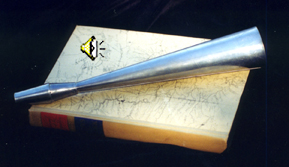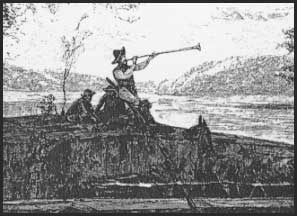As a bonus, those boatmen’s horns certainly made dandy New Year’s noisemakers.
In May 1803, when purchasing supplies for the expedition he and William Clark were soon to lead through the Northwest, Meriwether Lewis bought four “tin horns”—elsewhere called “Tin blowing Trumpets” or, by Sgt. Ordway, “Sounden [Sounding] horns”—from Philadelphia tinsmith Thomas Passmore for 50 cents apiece. Judging from the price, they probably were of the type commonly used on eastern canals for signaling between boatmen and lock-tenders or wharf workers.
The expedition was to leave Camp Dubois, near St. Louis, Missouri, in May 1804, in two large pirogues, and a custom-built 55-foot flagship they called “the barge,” or more commonly “the boat,” but never called a keelboat. The two pirogues were painted red and white, respectively, so they would be distinguishable at a distance, but when they were out of sight of the flagship horn signals may have been used to keep in touch. The horns also served to summon the men back to their boats for embarkation. On several occasions a horn was used to call in lost hunters (see Hunters, Lost and Found), but we read of that mainly when it was unsuccessful. En route up the Mississippi from the Ohio on November 22 and 23, 1803, for example, Lewis employed gunfire and horn blasts to summon Nathaniel Pryor, who was overdue from a hunting assignment, but the signals weren’t heard. When the signal worked, though, that wasn’t newsworthy. Evidently the horns were used quite a bit from the very start, for Clark had to send a couple of them from Camp Dubois to St. Louis to be repaired.
On two occasions Lewis referred to the horn as a trumpet, but a trumpet would have had a cupped mouthpiece in which the player’s lips would vibrate to set the air column in motion and produce a scale of two octaves or more.
The boatman’s horn, however, had only a simple mouthpiece containing a “reed” made of flexible metal, which vibrated when air was blown through it and produced a single pitch. It had no finger holes and therefore was useless as a musical instrument, although each horn possessed its own distinctive timbre and pitch, and with a little practice in blowing harder or softer, two or more tones, unique to each instrument, could be coaxed from it.
The Boatman’s Horn
by General William O. Butler[1]The first draft of “The Boatman’s Horn,” by then-28-year-old William Orlando Butler—who signed it with his middle name— was published in the monthly Western Review and … Continue reading
O, boatman! wind that horn again,
For never did the listening air,
Upon its lambent bosom bear
So wild, so soft, so sweet a strain!What, though thy notes are sad and few,
By every simple boatman blown,
Yet is each pulse to nature true,And melody in every tone.
How oft in boyhood’s joyous days,
Unmindful of the lapsing hours,
I’ve loitered on my homeward way
By wild Ohio’s bank of flowers;
While some lone boatman from the deck
Poured his soft numbers to the tide,
As if to charm from storm and wreck
The boat where all his fortunes ride!Delighted Nature drank the sound,
Enchanted echo bore it round
In whispers soft and softer still,
From hill to plain and plain to hill,
Till e’en the thoughtless, frolic boy,
Elate with hope and wild with joy,
Who gamboled by the river side,
And sported with the fretting tide,
Feels something new pervade his breast,
Change his light step, repress his jest,
Bends o’er the flood his eager ear
To catch the sounds far off, yet dear .
Drinks the sweet draft, but knows not why
The tear of rapture fills his eye.
And can he now, to manhood grown,
Tell why those notes, so wild, so lone,
As on the ravish’d ear they fell,
Bound every sense in magic spell?There is a tide of feeling given
To all on earth, its fountain Heaven;
Beginning with the downy flower
Just oped in Florio’s vernal bower,
Running each nice gradation through,
With bolder murmur, and with brighter hue;
That tide is Sympathy! Its fitful flow
Gives to this life its joy or two:
Music, the master spirit, that can move
Its waves to war, or lull them into love;
Can charm the starting tear from Beauty’s eye,
And bid the heart of virtue cease to sign;
Can cheer the dying sailor on the wave,
And shed bright halos round the Soldier’s grave;
Inspire the fainting Pilgrim on his road,
And elevate his soul and thoughts to God!Then Boatman! wind that Horn again!
Tho’ much of Sorrow mark its strain;
Yet are its sounds to Sorrow dear!
What tho’ they wake fond mem’ry’s tear?
Tears are mem’ry’s sacred feast,
Where Rapture sits a smiling guest.
Notes
| ↑1 | The first draft of “The Boatman’s Horn,” by then-28-year-old William Orlando Butler—who signed it with his middle name— was published in the monthly Western Review and Miscellaneous Magazine of Lexington, Kentucky, in the issue for July 1821. In that final issue the editor wrote:”If we have in any degree succeeded in creating or fostering a literary taste; if we have, to any extent, drawn out the resources of the scholars of the western country; if we have been instrumental in preserving for the future historian and for the admiration of posterity any of those interesting narratives, which contemporaries only could furnish, of the difficulties and dangers and almost incredible deeds of heroism that distinguished, and ought to immortalize, the early settlers in the West; if, in fine, we have successfully repelled a single unjust aspersion cast upon the American character, our exertions have not been in vain, and we have no cause to regret the existence, feeble and short-lived as it may have been, of the Western Review.” |
|---|
Experience the Lewis and Clark Trail
The Lewis and Clark Trail Experience—our sister site at lewisandclark.travel—connects the world to people and places on the Lewis and Clark Trail.
Discover More
- The Lewis and Clark Expedition: Day by Day by Gary E. Moulton (University of Nebraska Press, 2018). The story in prose, 14 May 1804–23 September 1806.
- The Lewis and Clark Journals: An American Epic of Discovery (abridged) by Gary E. Moulton (University of Nebraska Press, 2003). Selected journal excerpts, 14 May 1804–23 September 1806.
- The Lewis and Clark Journals. by Gary E. Moulton (University of Nebraska Press, 1983–2001). The complete story in 13 volumes.



